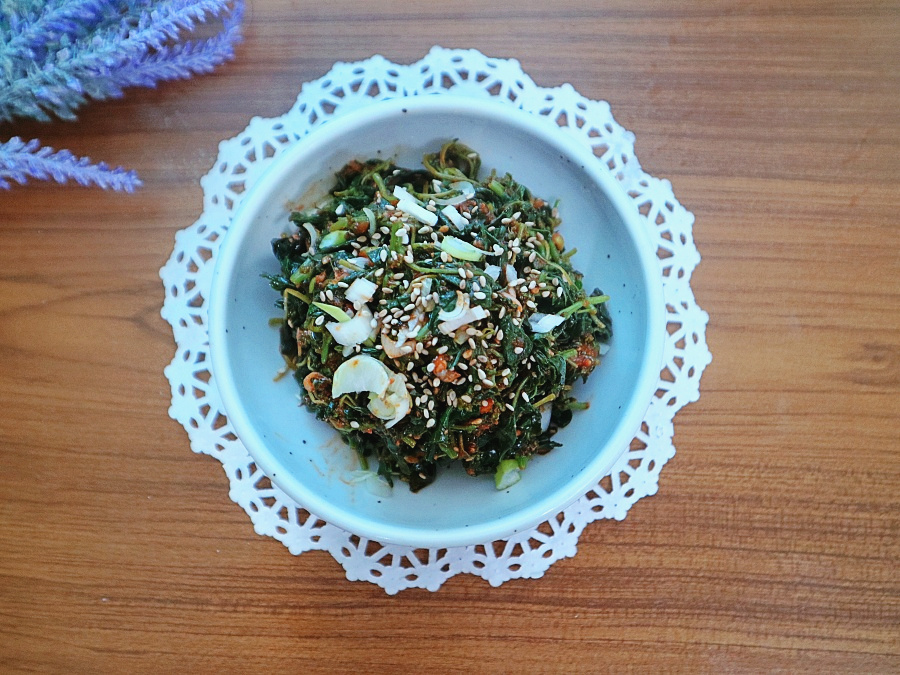Delicious and Crunchy Blanched Amaranth Salad with Gochujang Dressing
Spring Delicacy: Amaranth Salad with Gochujang – A Recipe for Health and Flavor

Amaranth, which becomes even more vibrant in spring, is a delicacy with a wonderfully tender yet crisp texture and a rich, nutty flavor. This recipe introduces a delicious amaranth salad dressed with gochujang, easily made with amaranth found at any supermarket. Rekindle the nostalgic taste of your childhood as you create this delightful amaranth salad. Its mild, savory taste makes it a dish you can enjoy every day without getting tired of it. We’ll also delve into the health benefits of amaranth, known for its rich nutrients that support vascular health, bone strength, and skin beauty!
Ingredients- 200g blanched amaranth (cleaned and prepared)
- 2 Tbsp chopped green onion
Seasoning- 1 Tbsp gochujang (heaping)
- 0.5 Tbsp minced garlic
- 0.7 Tbsp plum extract (maesilcheong)
- 0.7 Tbsp sesame oil
- 0.5 Tbsp toasted sesame seeds
- 1 Tbsp gochujang (heaping)
- 0.5 Tbsp minced garlic
- 0.7 Tbsp plum extract (maesilcheong)
- 0.7 Tbsp sesame oil
- 0.5 Tbsp toasted sesame seeds
Cooking Instructions
Step 1
Amaranth, also known as ‘Jangmyeongchae’ (long-life vegetable), is a charming green with a mild, savory, and nutty flavor, free from bitterness. It is rich in vitamins, minerals, and particularly potassium, which aids in eliminating sodium and toxins. It also contains abundant Omega-3 fatty acids, making it excellent for preventing osteoporosis and promoting bone health. Furthermore, its high vitamin content is beneficial for skin beauty, and its organic acids can help alleviate skin conditions and treat inflammatory acne. Amaranth offers numerous health benefits, including supporting vascular health, colon health, cancer prevention, wound healing, and reducing edema, making it a valuable addition to your diet.

Step 2
Let’s prepare the amaranth. First, trim off any yellowed or wilted leaves, keeping the thicker stems intact. Place the prepared amaranth in a bowl, cover it with water, and let it sit for about 5 minutes. This allows any soil or impurities to settle at the bottom. Then, rinse it thoroughly under running water and drain well. Be gentle when washing to avoid bruising the delicate leaves.

Step 3
Now, let’s blanch the amaranth. Fill a pot with enough water to cover the greens and bring it to a rolling boil over high heat. Once boiling, add 0.5 Tbsp of coarse salt and then add the prepared amaranth. Gently stir to ensure the greens are submerged, and blanch for just 30 seconds to 1 minute. The exact blanching time can vary, so it’s best to taste a leaf or check its tenderness midway to achieve your preferred texture. Avoid over-blanching, as it can make the amaranth mushy and lose its crispness.

Step 4
Immediately after blanching, quickly rinse the amaranth in cold water to cool it down. This helps maintain its vibrant green color and crisp texture. Gently squeeze out excess water by pressing the amaranth between your palms. Squeezing too hard can make the salad dry and tough, while not squeezing enough will result in a watery dressing that doesn’t adhere well. The key to a great namul salad lies in proper blanching and water removal. Practice makes perfect, so don’t be discouraged if your first attempt isn’t perfect! (Tip: Blanch a larger batch and freeze some for later, or prepare extra for the next day by washing and draining.)

Step 5
Let’s make the dressing for the amaranth salad. In a wide bowl, add 1 heaping tablespoon of gochujang. Then, add 0.5 Tbsp of minced garlic and 0.7 Tbsp of plum extract (maesilcheong). These fundamental ingredients will enhance the salad’s savory notes and overall flavor.

Step 6
Next, add 0.7 Tbsp of sesame oil for a nutty aroma and flavor, and 0.5 Tbsp of toasted sesame seeds for added crunch and taste. Mix all the dressing ingredients thoroughly with a spoon or spatula until well combined and smooth.

Step 7
Add the well-drained amaranth and chopped green onion to the prepared dressing. Gently toss and mix with your hands until everything is evenly coated. Amaranth can be simply seasoned with soy sauce for a clean, light taste, but dressing it with soybean paste (doenjang) or gochujang adds a deeper, richer flavor. Today, we’re making a gochujang-based amaranth salad, bringing out its profound umami. Amaranth salad is a true side dish that perfectly complements any meal!

Step 8
Transfer the finished amaranth salad to a serving plate, arranging it attractively. Finally, sprinkle a generous amount of toasted sesame seeds on top. Your delicious and visually appealing amaranth salad with gochujang is now complete! (Pro Tip: You can also mix gochujang and doenjang for the dressing, or use doenjang alone for a fantastic flavor. This gochujang-only version offered a wonderfully deep and savory taste!)

Step 9
Enjoy this amaranth salad with its crisp texture and savory, nutty flavor, enhanced by a delicious dressing. It’s a truly satisfying side dish that makes you want to finish your rice in no time! The recipe is straightforward and easy for anyone to follow. This wonderfully seasoned amaranth salad is also perfect as a topping for bibimbap (mixed rice). Enjoy this spring delicacy!



